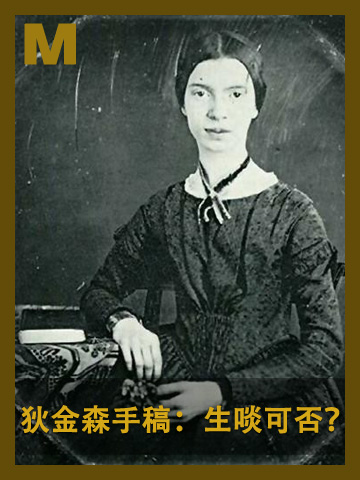艾米莉•狄金森是一个敢于挑战占据主导地位的男性诗人和编辑们在诗节形态、印刷出版、书籍分销、拼写读音、视觉和口头表达、情爱欲望等方面所树立的规范的激进先锋派诗人吗?抑或是一个克制的诗人,用少数几种传统形式的格律与诗节来自我设限,将任性不羁的惠特曼形容为“丢人现眼”,借一身拘谨的白裙表达在最为狂傲的“不”字中得到充分体现的克己之意?
这个问题可追溯至所谓的“两院之争”,当时狄金森的手稿被分为两大类。一类是作者寄给其嫂苏珊•狄金森的诗歌,另一类则是作者于1886年辞世之后其妹拉维妮娅在一只抽屉中发现的大量手稿。苏珊最先主动提出找人出版狄金森的诗作。然而拉维妮娅认为苏珊对实现这一目标不够热情,转而——看似是故意挑衅般地——求助于苏珊丈夫的情妇梅布尔•托特。对文学界更为熟悉的梅布尔与狄金森的创作导师托马斯•温特沃斯•希金森达成合作,共同担任该出版项目的编辑。
Was Emily Dickinson a radical poet of the avant-garde, challenging the regularized notions of predominantly male poets and editors regarding stanza shape, typographical publication and distribution, spelling and punctuation, visual and verbal presentation, erotic love, and so on? Or was she a poet of restraint, who restricted herself to a few traditional patterns of meter and stanza, referred to the wayward Whitman as “disgraceful,” and wore her prim white dress as a sign of those renunciations best expressed in that wildest word “No”?
It is a conflict reaching back to what has come to be called “The War Between the Houses,” when Dickinson’s manuscripts were divided into two main collections. One consisted of the poems Dickinson had sent to her sister-in-law, Susan Dickinson. The other was the pile of manuscripts discovered in a drawer after Dickinson’s death in 1886 by her sister, Lavinia. Susan had first volunteered to find a publisher for Dickinson’s poetry. When in Lavinia’s view she showed insufficient zeal in pursuing this goal, Lavinia turned—in what seems a deliberate act of hostility—to Susan’s rival for her husband’s affections, Mabel Todd. Todd, more comfortable in the literary world, secured the cooperation of Dickinson’s literary adviser Thomas Wentworth Higginson as coeditor for the project.
阿默斯特和哈佛——两座历史上曾仅招收男学生、狄金森不可能进入的学府——就收录狄金森作品的数据库应该包含哪些内容、以何种形式展示的问题上出现了分歧,掀起了所谓的“两院之争”。借用人类学用语来描述的话,这两种学术倾向或许可以比作对狄金森的“生啖”与“熟食”。
- 狄金森手稿:生啖可否?
- Dickinson: Raw or Cooked?
- 书评 写书评
- 笔记
-
书评加载中...























 京公网安备 11010802032529号
京公网安备 11010802032529号
笔记加载中...